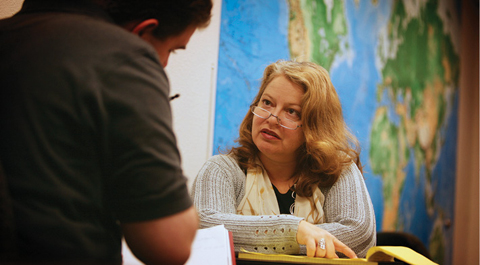Preparing for disaster
Anthropology professor's research could aid personal recovery.
Natural disasters have dominated the headlines this year, from earthquakes in Japan to floods in Mississippi to tornados across the Midwest. While climate change has been an emerging topic of interest to the world community, little scientific data is available addressing how people respond to climate-related events.
Dr. Sara Alexander, an applied social anthropologist at Baylor, has worked with a team studying different types of households in several coastal communities in Belize. The group has identified vulnerable households in these communities and examined how they coped and adapted in recent years to major climate events and shocks such as droughts, hurricanes and floods. Funded by a $237,000 grant from the National Oceanic and Atmospheric Administration (NOAA), the Baylor researchers also developed tools to measure each household's long-term resilience, an area that has not been extensively researched when it comes to humans, and identified specific behaviors and strategies that allowed some families to "weather the storm" better than others.
Baylor Magazine sat down with Alexander to learn more about how her research can help those affected by such events, be they in Belize City, Tokyo, Vicksburg or Joplin.
Based on your findings, what can communities do to reasonably prepare for or recover from a natural disaster?
In Belize, when there's a tropical storm or hurricane coming, residents usually have several days' notice. They are all aware of the evacuation procedures, and if the government calls for it, people immediately board up windows.
But when Hurricane Iris went through one of our study communities in 2001 and obliterated 95 percent of all structures, the locals generally rebuilt in thatched roofs, which means they will not be eligible to receive relief aid in the event of another disaster. Why? They conducted their own cost-benefit analysis -- when tourists go to the tropics for vacation, they want to experience the native way of life; in this case, that includes thatched roofs.
Societies in our world today indicate various gradations of being proactive and reactive. As Americans, we're members of more of a reactive society. Not to say we don't have any preparation, but generally, we wait for the disaster to happen and then we try to deal with it.
Concerning the tornado devastation in Missouri and Alabama ... Tornado Alley has been known as such for decades. It is curious to me that it's not very common for people to take the precaution of having storm cellars or safe rooms in their homes. Yes, there is an economic cost that has been prohibitive for many. But with the escalation of tornadoes that is most likely to continue, I predict the risk of losing human life for many will now outweigh the cost and more cellars will be built. That is, we will become more proactive over time as one of our adaptations to the climate fluctuations.
Tell us more about what you're doing and finding in Central America.
Right now, we are studying the coastal communities of Belize and the effects of their natural disasters -- hurricanes, tropical storms, extended droughts and mudslides -- on the population. An increase in temperature over time is indicated, and this has already begun to affect these communities, which are economically dependent on reef-based tourism.
Vulnerable households in Belize, given the structure of the government relief aid that's available, cannot easily access financially-
oriented relief apart from food aid. For instance, if you have a wooden structure as your home or a thatched roof structure -- which a predominantly Mayan population traditionally prefers -- then you are not eligible for relief assistance.
So, the more vulnerable households are relying on emotional or spiritual responses. They're going to churches, spending time in prayer groups, going to friends and family for assistance, and perhaps depending on remittances from family members in the U.S. Households with savings or easier access to credit, those that are more secure financially, tend to have had initial structures before the climate event that involved cement construction, which is more expensive. Yet as a consequence they were insured, and also have access to government relief. In the end, their responses are more financial, what I would call physical. They're repairing and rebuilding as quickly as they can.
What lessons do you hope to find that can be applied to other countries and events?
Our research provides a means for measuring livelihood security, i.e., a way to identify a vulnerable household versus a more secure one. If there are some patterns in response to climate events across countries or regions, it would be critically important to know this before agencies and non-governmental organizations (NGOs) offer disaster assistance or long-term mitigation strategies.
How one defines vulnerability might be different in Japan than it is in Belize, but to go through the process of determining how a community defines their own vulnerability is extremely helpful and translates well to different regions. We can learn from each event in terms of which strategies were more or less successful. If we can identify universal coping mechanisms that work everywhere, this information will be particularly useful in working to facilitate appropriate and effective responses to climate-related events.
We are in the process of final data analysis and will be publishing these findings in several journals, including Climatic Change and Human Ecology. There is a movement in the social sciences worldwide to explore effective and reliable ways to document human resilience to climate-related events, and I hope to be able to contribute to this research in meaningful ways.
